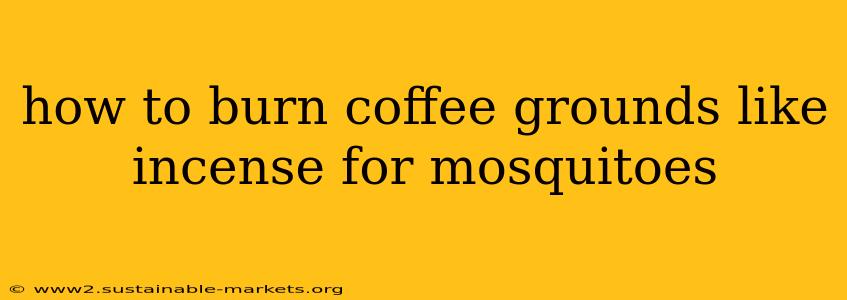Mosquitoes are a persistent nuisance, especially during warmer months. While chemical repellents are readily available, many people seek natural alternatives. Burning coffee grounds as a mosquito repellent is one such method, gaining popularity for its purported effectiveness and readily available ingredient. However, it's crucial to understand the science behind this method and how to do it safely and effectively.
Does Burning Coffee Grounds Actually Repel Mosquitoes?
The claim that burning coffee grounds repels mosquitoes isn't definitively proven by rigorous scientific studies. The effectiveness likely stems from several factors:
-
Smoke: The smoke produced when burning coffee grounds contains various compounds that can irritate mosquito sensory organs, potentially deterring them. The smoke itself can also act as a physical barrier, making it harder for them to reach you.
-
Aroma: The strong, smoky aroma of roasted coffee beans can mask other scents that attract mosquitoes, such as carbon dioxide from your breath and body odor. This masking effect might reduce the likelihood of mosquitoes finding you.
-
Heat: The heat generated by burning coffee grounds can create a localized area of discomfort for mosquitoes, driving them away from the immediate vicinity.
It's important to note that the effectiveness of this method can vary significantly based on factors like the type of coffee grounds used, the intensity of the burn, wind conditions, and the mosquito population density. It's unlikely to be a complete solution, but may offer some level of supplementary protection.
How to Safely Burn Coffee Grounds as a Mosquito Repellent
While generally safe, burning coffee grounds requires caution to avoid potential hazards:
1. Preparation and Materials:
- Coffee Grounds: Use freshly brewed coffee grounds; stale grounds might not burn as efficiently. Avoid using grounds that contain additives or chemicals.
- Heat-Resistant Container: Choose a heat-resistant container like a small metal bowl, a heat-safe ceramic dish, or a purpose-built incense burner. Never use flammable materials.
- Ventilation: Ensure adequate ventilation in the area where you'll be burning the coffee grounds. Burning coffee grounds will produce smoke, which can irritate the respiratory system if inhaled in large quantities.
- Safety Precautions: Always have a source of water or sand nearby to extinguish the burning grounds if needed. Never leave burning coffee grounds unattended. Keep away from flammable materials.
2. Burning the Coffee Grounds:
- Small Amounts: Start with a small amount of coffee grounds. Add more gradually as needed, rather than overloading the container.
- Gentle Ignition: Light the coffee grounds gently using a match or lighter. Be careful not to burn yourself.
- Maintain a Low Burn: Avoid a large, intense flame. Aim for a slow, smoldering burn that produces a steady stream of smoke, not a large fire.
- Monitor Regularly: Keep a close eye on the burning coffee grounds to ensure they don't flare up or spread.
3. Important Considerations:
- Effectiveness Varies: The effectiveness of this method is not guaranteed. It's best used as a complementary strategy alongside other mosquito repellents, such as mosquito netting or DEET-based sprays.
- Air Quality: Burning anything produces smoke, impacting air quality. Be mindful of this, especially for people with respiratory sensitivities.
- Alternatives: Explore other natural mosquito repellents such as citronella candles or essential oils (like lemongrass or peppermint). These options often offer a more reliable and less smoky alternative.
Conclusion: A Natural Approach with Limitations
Burning coffee grounds as a mosquito repellent offers a natural, readily available, and relatively low-cost approach. However, it's important to approach it cautiously and realistically. Its effectiveness is limited and should not be considered a primary defense against mosquitoes. Combine it with other effective methods for optimal protection. Remember safety is paramount. Always prioritize safe handling and adequate ventilation.

